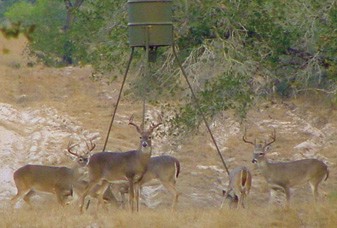
White-tailed deer habitat consists or food, water, shelter, and also space. Thus, food plots and supplemental feeding only impact the nutritional carrying capacity of a particular piece of property, not the total or actual carrying capacity. Assuming there are both adequate water and cover, supplemental feeding can greatly increase the number of the local deer population. Supplemental feeding has become commonplace in deer management programs across the country, but is it healthy?
One thing to keep in mind is the amount of space and and habitat per deer decreases as the population size increases! More deer in an area means less area for each individual deer. This may not be a problem if the number of deer is below the carrying capacity of the area, but this rarely seems to be the case with white-tailed deer.
One of the arguments used by those in support of supplemental feeding is that it not only enhances the nutrition and resulting health of the deer, but that it could possibly take pressure off of the natural vegetation by decreasing deer browsing. Unfortunately, there is little data to support this and plenty of data to refute it.
The use of food plots, supplemental feeding, and baiting has been greatly debated throughout the U.S., but should this extra nutrition really be included as part of the carrying capacity estimates for your property? The research says no.
Studies in Texas have show that fed deer can degrade habitat by over-consuming high-quality browse and under-consuming low-quality plants. Other data found increased browse pressure within a 1-mile radius of feeders, which can only be attributed to the concentration of deer!

This research does, however, have a silver lining for hunters. Several studies have found that the home range of a deer becomes smaller when feeders are present. One research project even found that home range sizes of fed deer were 50% of that of unfed deer. But that good news does not come without a price. Browse pressure near the feeders was 7 times that of habitat occupied by unfed deer.
In addition to degrading habitat adjacent feeders, supplemental feeding has been suspected of contributing to the spread of certain diseases within various species of North American ungulates, such as tuberculosis in deer, chronic wasting disease in elk and deer, and brucellosis in elk and bison.
So what does all this mean? Well, if you wish to provide supplemental feed — make sure that it is in fact supplemental. Avoid using the addition of food resources as justification to artificially inflate deer numbers on a property and subsequently degrade habitat. In addition, make sure you understand that feeders do concentrate deer (even if individual deer use the feed site at different times) and does make them more prone to disease.
You are all “worried” about deer overpopulation and deer vehicle accident, but you reject the deer birth control even knowing it works and its safe.
Hey Caroline TC, thanks for visiting the site. First, deer overpopulation is an issue, but not in many areas where deer can be legally hunted. I don’t blame hunters or deer for vehicular accidents, but obviously in areas where deer do over-populate, such as in areas where they can not be legally hunted, there are many deer/auto collisons caused by hunters and mostly non-hunters (since only about 10% of people hunt.)
Also, with regards to birth control and deer management, birth control is not effective in free-range populations. Does must ingest the BC everday and that can not be guaranteed in the wild. Also, who is going to pay for the BC? In Texas, we have 2 million whitetail does–that’s a lot of pills! Hunters foot the bill for wildlife management for both game and non-game species.